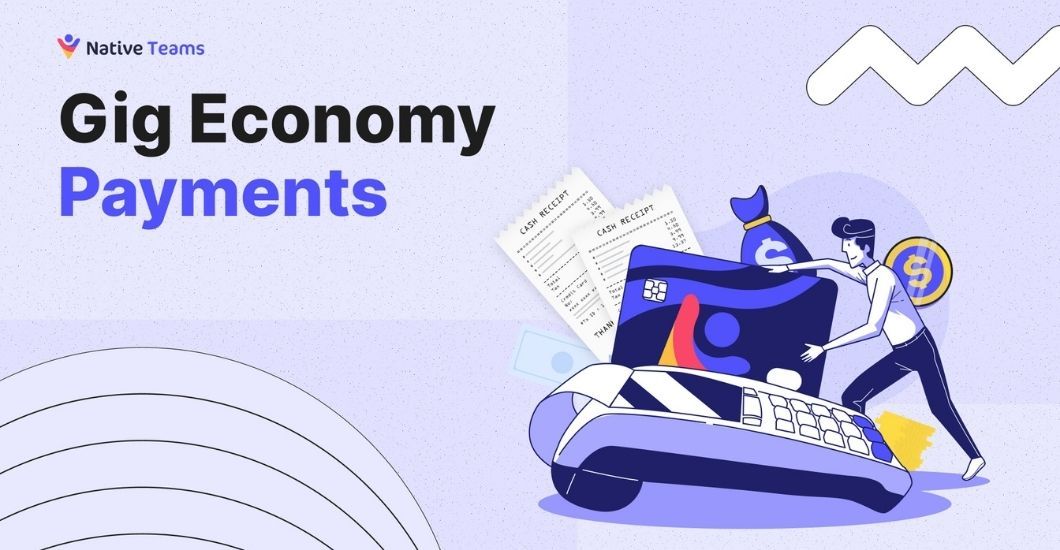Gig Economy Payments
One of the most significant benefits of the gig economy is that it allows independent workers to maintain financial stability by working on their own terms. However, working within the gig economy imposes some challenges, and managing payments are among the most significant ones.
In this article, we cover everything you should know about gig economy payments – ways of payments, common issues, the future of payments, and more.

Does the gig economy change payments and how?
While traditional employment arrangements involve fixed weekly or monthly payments, the nature of the gig economy is significantly different. The gig economy is characterised by project-based, short-term arrangements, which introduced new payment models and concepts.
For instance, some gig economy sectors such as ride-sharing and food delivery utilise digital payment apps for direct payments between gig workers and clients. On the other hand, project-based work requires on-demand payments after completing certain gigs or tasks.
Not only does the gig economy change traditional payment concepts, but it also contributes to the rise and development of digital payment technologies, such as digital currencies, payment platforms, mobile wallets, and others.
How do gig workers get paid?
One of the advantages of working in the gig economy is the flexibility it offers, especially when it comes to payments. Gig workers can choose how they want to be paid – whether it’s per hour, per project, or a fixed price for certain services they provide.
Regardless of the nature of payment, gig workers utilise different payment methods, among which are:
- Gig platforms’ payment systems – Freelancers typically get paid through gig economy platforms’ integrated payment systems. Such platforms hold freelancers’ funds until the gig worker withdraws them to a linked payment method.
- Digital payment platforms – Many gig workers get paid through digital payment platforms, such as Native Teams, PayPal, Payoneer, and similar.
- Direct payments – Direct deposits through bank accounts are also among the most convenient and secure payment methods for freelancers and independent contractors.
- Peer-to-peer payments – In some gig economy sectors, workers can receive payments directly from customers through peer-to-peer payment apps and platforms.
- Cash or cheque payments – Independent contractors who provide offline services can receive cash or cheque payments from clients.

The current payment problem
As a more convenient and efficient income-making model, the gig economy facilitates flexibility and a better working environment for independent workers. However, the flexible nature of the gig economy also imposes several challenges and payment-related issues that may hinder the financial stability of gig workers. Here are some of the current payment problems and challenges with payments for the gig workforce:
- Income instability – Many of the sectors in the gig economy are characterised by fluctuating demands, imposing an unstable volume of gigs and arrangements. Therefore, many gig workers tend to experience irregular income patterns which leads to financial insecurity.
- Cash flow issues – Depending on the payment method used, gig workers experience major cash flow issues. This is due to some platforms featuring payment schedules that require waiting before the individual can access their earnings.
- Lack of transparency and fair practices – Some gig workers may not have a clear understanding of how their payments are calculated, as well as the breakdown of fees and deductions. There are also cases where gig workers experience underpayment, arbitrary payment adjustments, and exploitation. The lack of standardisation in payments, and the unpredictability of the gig economy are additionally contributing to this issue.
- Lack of benefits – As the gig economy concept is different from traditional employment, gig workers often don’t have access to health insurance, pension plans, paid time off, and other benefits. Gig workers are required to submit such financial burdens on their own, which can lead to increased work expenses, and contribute to financial instability.
The future of payments in the gig economy
The continuous evolution of the gig economy holds promising trends and developments in addressing common payment issues. Here are some of the potential changes that are projected to happen in the future:
- Cryptocurrency impact – The general rise of cryptocurrencies and blockchain technology may transform payments in the gig economy. Decentralised payment platforms may be beneficial for gig workers, as they feature faster and more secure transactions while lowering transaction costs.
- Real-time payments – Technologies facilitating real-time transactions will become more prevalent. Gig workers will be able to receive their earnings immediately after completing arrangements, and hence, secure better cash flow management and financial stability.
- More integrated payment services – Gig platforms are already working towards improving and advancing their payment systems to ensure seamless transactions. Gig workers may gain access to financial tools and payment-tracking technologies that will improve their overall income management.
- Enhanced choice of payment methods – The rise of digital technologies and the gig economy will contribute to the development of more advanced payment methods. Gig workers will be able to use decentralised payment solutions, peer-to-peer payment apps, and even technologies such as biometric payment systems.
- Collaborations with financial institutions – With the growth of the gig economy, financial institutions are already working on the development of financial products and services. In future, gig workers will have access to better retirement saving options, insurance packages, specialised loans, and other features.
- Legal protection – As the gig economy is on the constant rise, governments are more likely to introduce regulations that protect gig workers’ payment rights and promote fair payment practices.

Wrapping Up
The gig economy imposes much different payment practices than those in traditional employment relationships, which leads to several challenges and issues. Compared to traditional 9-5 roles, gig workers experience unstable flows of income, nontransparent and unfair payment practices, and a lack of work benefits.
However, as the gig economy is on the constant rise, there are also growing trends that address common payment issues for gig workers. Solutions such as decentralised payment systems, advanced gig platforms and payment methods, and consistent collaboration with government bodies and financial institutions will shape payments and contribute to better working conditions within the gig economy.
